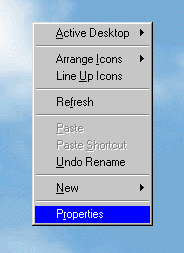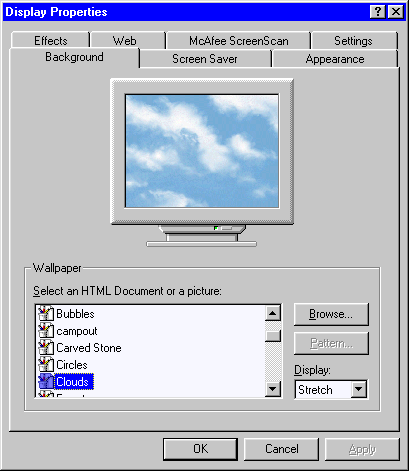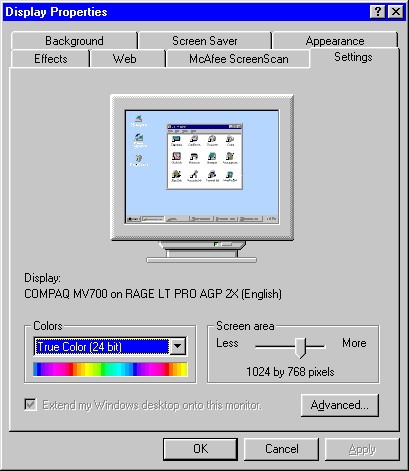
Checking your screen settings.
Changing your screen settings may cause problems if you try to select a higher screen resolution or number of colours than your screen is actually capable of supporting, although if your system is correctly configured, you should only be offered settings that will work.
You are advised to check your system's documentation before changing your display settings, to make sure that it should support the settings you wish to use.
IF IN DOUBT, DON'T CHANGE IT - CONSULT YOUR DOCUMENTATION AND/OR SYSTEM SUPPLIER.
Before starting, it might be a good idea to PRINT these instructions, save all your work in any programs other than this browser window, and close them all.
1. Reduce the size of this browser window so that some part of the screen background is visible.
2. Right-click the mouse on the screen background. This will show a menu like this:

3. Select the 'Properties' menu item, and the result should be a screen like this:

4. Your system may not show all the tabs shown here, or may show additional tabs, depending on exactly which version of the operating system you are using, what display hardware you are using, and what kind of anti-virus tools you have installed.
Click the 'Settings' tab, and you should get a display something like this:

5. Make a WRITTEN note of all the current settings on this dialog.
6. Make sure that the 'Colors' setting is at "High Color (16 bit), "True Color (24 bit)" or "True Color (32 bit)" if these settings are available on your system.
7. Make sure that the 'Screen area' is set to "800 by 600 pixels" or higher, if this is available on your system.
8a. Under Windows NT4 and Windows 2000, there is a "Test" button that you should use at this point. Press 'Test', and the system will try out your display settings, and ask you if they worked. If the display breaks up at this point, do not worry - after a few seconds it will change back and accept that the settings did not work.
If the settings worked, you may now press the "Apply" button to activate these settings, followed by the "OK" button to complete the process.
If the settings did not work, you should press the "Cancel" button and consult your system documentation or equipment supplier.
8b. Under Windows 95 or 98, press the "Apply" button. The settings will change, and Windows will ask if you want to keep the new settings. If the display breaks up at this point, do not worry - after about 15 seconds, it will change back and accept that the settings did not work.
If the settings worked, you may now press the "OK" button to complete the process. If the settings did not work, you should press the "Cancel" button and consult your system documentation or equipment supplier.
In some cases, when you press the "Apply" button, Windows may ask to restart your system. It's your call - you won't get an opportunity in this case to test the new settings. If everything works, then when the system restarts, it will start in the new settings. If it fails, the system may restart with a broken up display.
Fixing this will require you to reboot your computer into SAFE MODE - pressing function key F5 continuously during the reboot will usually do this. From SAFE MODE, put the settings back to their original values, and restart your system.
If in doubt, consult your system supplier before changing any of these settings.